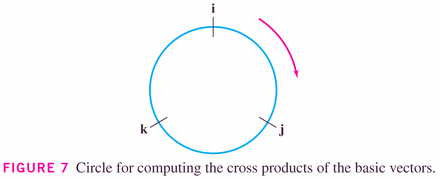- Reminder: Homework problems:
- pp. 665-, #22, 30, 38, 59, 60 (due Tuesday, 12/9).
- pp. 673-674, #13, 18, 22, 26, 45, 50, 51 (due Thursday, 12/11).
- pp. 680-683, #2, 7, 8, 14, 16, 41, 42, 60, 70, 71 (due Friday, 12/12).
- A problem or two from 13.4/13.5 will appear on the final.
- Last time we defined a product of two vectors (resulting in a scalar, or number) as follows:

It turns out that

where




Otherwise, the angle is acute. We put it all together to get this result, which shows us how to use the dot product to define components:

Examples:
- #69, p. 682
- #79, p. 683
- We then went on to consider parametric equations of lines, starting from uniform circular motion. As we saw in that case,
and
But that
and that
.
We "cut the string" holding the particle (or planet!) in uniform circular motion, and found the equation of the line along which it would move to be the following:

Examples:
- #46, p. 674
- #52, p. 674
- Section 13.4: The Cross Product
- The next product we'll find convenient to define is the cross
product, which is a product of two vectors resulting in a third vector,
which juts into the space perpendicular to which the two vectors live. It is
only useful in three-space, which makes it somewhat unusual (the dot product
exists and is useful in any dimensional space).
Because the cross product is linear in the components, we can define it on the unit vectors in three space, and then deduce it using the component-wise definition of a three-vector.





Examples:
- #20, p. 691
- #28, p. 691
- The force
on a proton moving at velocity
(in m/s) in a uniform magnetic field
(in teslas) is
(in Newtons), where
Coulombs:

#36, p. 692
- Torque: #64, p. 693
- The next product we'll find convenient to define is the cross
product, which is a product of two vectors resulting in a third vector,
which juts into the space perpendicular to which the two vectors live. It is
only useful in three-space, which makes it somewhat unusual (the dot product
exists and is useful in any dimensional space).